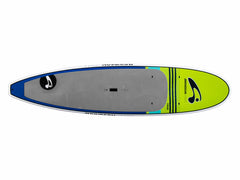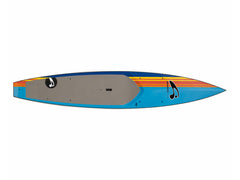Selecting a SUP: A General Discussion
Choosing a SUP can be an overwhelming. Here are some things to think about before you go out and buy your first SUP or go to upgrade your current board.
Where are you going to paddle? (flat-water, river, surf)
What is your skill level?
How much do you weigh?
How far will you paddle?
What are your goals?
Volume= Stability
Length, Width and thickness are all of utmost importance. They, along with paddler stature, are going to determine how stable a board will be. Length, width and board thickness will determine the boards volume, the higher volume the board the more stable it will be. Know that what is stable for one person may not be stable for another. As the weight of the rider increases the volume of the board should increase as well. However there are lots of large paddlers that ride small boards. Those paddlers have had some practice and do so to gain maneuverability and control.
Selecting a SUP for the Surf: *First things first before you head out into the surf, familiarize yourself with the do's and don'ts of the line up and the environment to keep yourself and others safe.
When selecting a board for the surf a main design feature to consider is Rocker. Rocker is the amount of bend to the board. The more the board looks like a banana the more rocker it has. Going one step further the term can be divided into nose rocker and tail rocker. Boards that are used in the surf typically have a fair amount of nose rocker to get the board from Pearling or nose diving. The slight up turn will allow the board to plane quicker as the tail is picked up by the wave. The reason there is rocker in the tail of a surf specific SUP is fairly straight forward. Because the board often contacts the wave at odd angles having that little bit of tail rocker helps to promote a suitable outline to allow for better more control.
Nose Shapes: Bigger broader nose shapes will allow for quicker planing and added stability, especially as you work your way out onto the nose. A pointed nose will board will be less buoyant but you will have more control and maneuverability to carve turns on the face of the wave.
Tail Shapes: Broader square tails will give the board added stability but will decrease its maneuverability on the face of a wave. A pulled in tail will be a bit less stable on flat water but since the tail is pulled in to a point it will carve back and forth in the wave much easier. *Remember that in the surf the SUP will be much more stable on a wave.
Rail Thickness (outline or side of the board): Thinner or low rails will allow the board to carve on the wave by providing more"bite". Thinner rails also make the board less buoyant so make sure that you are matching board thickness with stature and ability. Thicker or high rails make the board more stable but will not "bite" into the face of the wave as well when turning the board.
Browse All Around SUP's
Selecting a board for Flat-water/Touring: Flat-water and touring SUP's are excellent for all ability levels and ages.
These are typically displacement boards, meaning that instead of the board planing over the surf of the water the nose pierces the water making it more efficient and allowing the board to track better (paddle in a straight line). Again it is important to match the volume of your board with your stature. There are design features that will make board speed, tracking and stability vary greatly. Board length, board width, rocker, rail shape and tail shape all effect how the board will perform.
Board Length: Longer boards are faster but less maneuverable
Board Width: Narrow boards are faster but less stable
Rocker: A bit of nose rocker will help the board perform in chop and down wind but will slow the board in flat water.
Rail Shape: Can be described as Low to High. A low rail describes the shape of the edge of the board. Lower rail essentially means the deck of the board is closer to the water (Less Stable). A high rail means that the deck height is higher (More stable). Low rails make the board turn better but make the board less buoyancy. High Rails make the board more buoyant but much more difficult to turn (on a wave). So most flat-water/touring boards have Mid High to High rails.
Tail shape: A broad square tail will make the board faster but less stable, a pulled in tail or pin-tail will make the board faster but less stable.
Browse Displacement Stand Up Paddle-Boards
Selecting a Race Board: Racing is the fastest growing sector in SUP right now. Folks of all ages are heading out onto the water and testing there mettle in a variety of formats.
The board you choose for racing will depend on the following: Your Stature, Ability Level, Budget and type of race. In SUP racing there are a variety of formats to compete. Races are broken up into divisions based on experience and board length. Most smaller stature paddlers choose to compete in the smallest board division which is 12'6". Paddlers over 185lbs will almost always be in the 14' division. There is also the unlimited division that gathers all the boards over 14'. There are divisions with in the unlimited class but we will just leave it at over 14'.
The Course Race: Pits racers against each other on a marked course. The course can be any shape and take place on flat-water or within the surf zone. Typically the course is marked with large buoys that racers are required to round. A board for a course race needs to be fast and nimble. These boards will often have square tails to give the athletes a bit of stability especially when stepping back on the tail for a pivot turn around the buoy's.
Flat-Water Race: This race will of course take place in "flat-water", conditions dependent on mother nature. These races very seldom require racers to round buoys or marks. They are often longer races that will start at one location and finish at another. Typically these races require both speed and endurance so it is important to choose a board that will allow both. Flat water race boards will have very little rocker to make the board more efficient and to keep the board tracking. They will also typically have square tales and high rails for stability. Remember we are trying to paddle fast over a long period of time so you don't want to be have to fight to stay balanced on a board, you will be burning energy. Lastly, a lot of the flat water race boards will have a slightly sunken or dropped deck. So the deck where you will be standing will be lower than the sides and nose of the board. This lowers the center of gravity making the board more stable. By dropping the deck you can do things like add a pin-tail for added speed or a rounder bottom and compensate for the instability that comes with doing so. In short there is a line you walk between performance and practicality. That is why is is very important to paddle a board before you buy it.
Downwind Race: As the name implies take place running downwind. Paddlers may also encounter "quartering" seas which hit the board at an angle to the direction you want/need to travel.
A downwind board is a bit of a combination of a surf and flat water SUP. Since you will be surfing a lot of time during a downwind race it is important to have a board with some rocker to keep from burying the nose every time you catch a bump. Second, since conditions for a down wind race usually mean a significant amount of wave action and or chop high rails and a square tail will help stabilize the board as the athlete weaves in and out of the bumps. In short a good down wind board is a planing board that has a bit of rocker in the nose, high rails and a square tail for stability. Remember if you can't stay on the board with out falling in you aren't going to be very fast.
Hopefully you have a learned a bit and gained some insight as you navigate the endless options when selecting the right stand up paddle-board for you. If you have any questions, we are always happy to help so give us a ring (360) 297-4659, send us an email or use the instant chat!
Forrest Wells
Olympic Outdoor Center Manager




